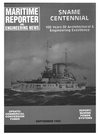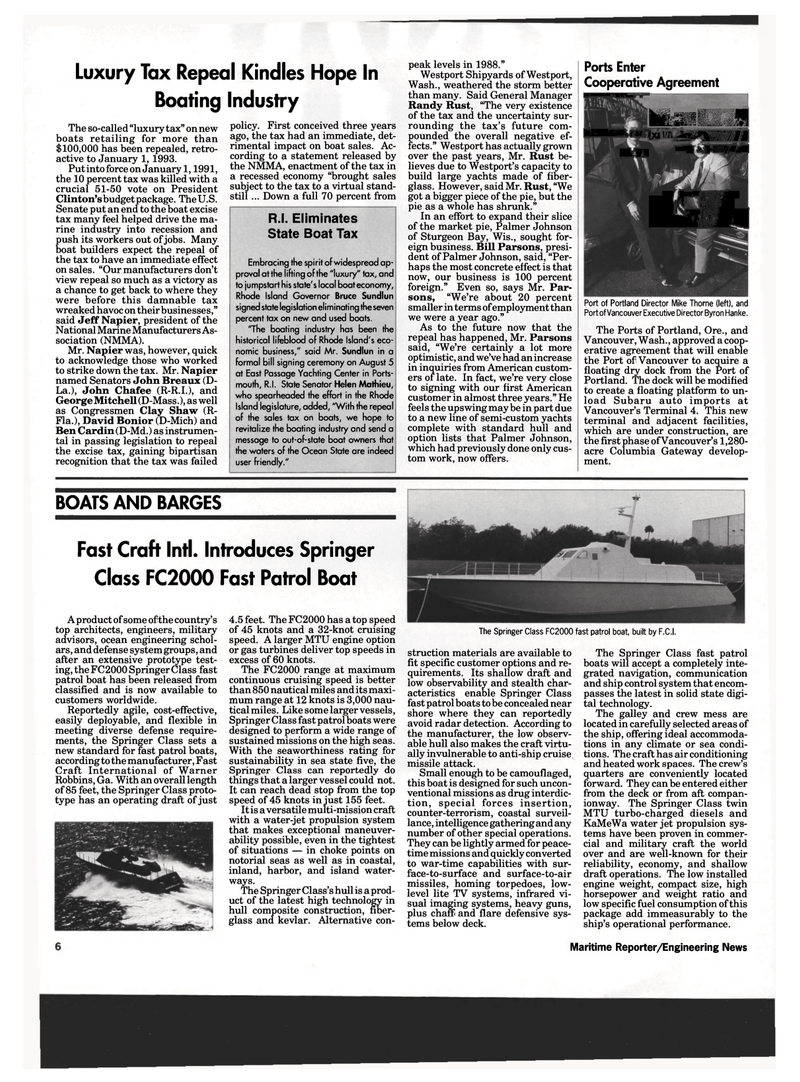
Page 4: of Maritime Reporter Magazine (September 1993)
Read this page in Pdf, Flash or Html5 edition of September 1993 Maritime Reporter Magazine
Luxury Tax Repeal Kindles Hope In
Boating Industry
The so-called "luxury tax" on new boats retailing for more than $100,000 has been repealed, retro- active to January 1, 1993.
Put into force on January 1,1991, the 10 percent tax was killed with a crucial 51-50 vote on President
Clinton's budget package. The U.S.
Senate put an end to the boat excise tax many feel helped drive the ma- rine industry into recession and push its workers out of jobs. Many boat builders expect the repeal of the tax to have an immediate effect on sales. "Our manufacturers don't view repeal so much as a victory as a chance to get back to where they were before this damnable tax wreaked havoc on their businesses," said Jeff Napier, president of the
National Marine Manufacturers As- sociation (NMMA).
Mr. Napier was, however, quick to acknowledge those who worked to strike down the tax. Mr. Napier named Senators John Breaux CD-
La.), John Chafee (R-R.I.), and
George Mitchell (D-Mass.), as well as Congressmen Clay Shaw (R-
Fla.), David Bonior (D-Mich) and
Ben Cardin (D-Md.) as instrumen- tal in passing legislation to repeal the excise tax, gaining bipartisan recognition that the tax was failed policy. First conceived three years ago, the tax had an immediate, det- rimental impact on boat sales. Ac- cording to a statement released by the NMMA, enactment of the tax in a recessed economy "brought sales subject to the tax to a virtual stand- still ... Down a full 70 percent from
R.I. Eliminates
State Boat Tax
Embracing the spirit of widespread ap- proval at the lifting of the "luxury" tax, and to jumpstart his state's local boat economy,
Rhode Island Governor Bruce Sundlun signed state legislation eliminating the seven percent tax on new and used boats. 'The boating industry has been the historical lifeblood of Rhode Island's eco- nomic business," said Mr. Sundlun in a formal bill signing ceremony on August 5 at East Passage Yachting Center in Ports- mouth, R.I. State Senator Helen Mathieu, who spearheaded the effort in the Rhode
Island legislature, added, "With the repeal of the sales tax on boats, we hope to revitalize the boating industry and send a message to out-of-state boat owners that the waters of the Ocean State are indeed user friendly." peak levels in 1988."
Westport Shipyards of Westport,
Wash., weathered the storm better than many. Said General Manager
Randy Rust, "The very existence of the tax and the uncertainty sur- rounding the tax's future com- pounded the overall negative ef- fects." Westport has actually grown over the past years, Mr. Rust be- lieves due to Westport's capacity to build large yachts made of fiber- glass. However, said Mr. Rust, "We got a bigger piece of the pie, but the pie as a whole has shrunk."
In an effort to expand their slice of the market pie, Palmer Johnson of Sturgeon Bay, Wis., sought for- eign business. Bill Parsons, presi- dent of Palmer Johnson, said, "Per- haps the most concrete effect is that now, our business is 100 percent foreign." Even so, says Mr. Par- sons, "We're about 20 percent smaller in terms of employment than we were a year ago."
As to the future now that the repeal has happened, Mr. Parsons said, "We're certainly a lot more optimistic, and we've had an increase in inquiries from American custom- ers of late. In fact, we're very close to signing with our first American customer in almost three years." He feels the upswing may be in part due to a new line of semi-custom yachts complete with standard hull and option lists that Palmer Johnson, which had previously done only cus- tom work, now offers.
Ports Enter
Cooperative Agreement
II MM J fa: i • 8 fiHHHRk ima IXJl/R J § mn •Bp^ |n JpMKpM ^H JRW.^; JIB
Kf tm
Port of Portland Director Mike Thorne (left), and
Port of Vancouver Executive Director Byron Hanke.
The Ports of Portland, Ore., and
Vancouver, Wash., approved a coop- erative agreement that will enable the Port of Vancouver to acquire a floating dry dock from the Port of
Portland. The dock will be modified to create a floating platform to un- load Subaru auto imports at
Vancouver's Terminal 4. This new terminal and adjacent facilities, which are under construction, are the first phase of Vancouver's 1,280- acre Columbia Gateway develop- ment.
BOATS AND BARGES
Fast Craft Intl. Introduces Springer
Class FC2000 Fast Patrol Boat
A product of some of the country's top architects, engineers, military advisors, ocean engineering schol- ars, and defense system groups, and after an extensive prototype test- ing, the FC2000 Springer Class fast patrol boat has been released from classified and is now available to customers worldwide.
Reportedly agile, cost-effective, easily deployable, and flexible in meeting diverse defense require- ments, the Springer Class sets a new standard for fast patrol boats, according to the manufacturer, Fast
Craft International of Warner
Robbins, Ga. With an overall length of 85 feet, the Springer Class proto- type has an operating draft of just 4.5 feet. The FC2000 has a top speed of 45 knots and a 32-knot cruising speed. A larger MTU engine option or gas turbines deliver top speeds in excess of 60 knots.
The FC2000 range at maximum continuous cruising speed is better than 850 nautical miles and its maxi- mum range at 12 knots is 3,000 nau- tical miles. Like some larger vessels,
Springer Class fast patrol boats were designed to perform a wide range of sustained missions on the high seas.
With the seaworthiness rating for sustainability in sea state five, the
Springer Class can reportedly do things that a larger vessel could not.
It can reach dead stop from the top speed of 45 knots in just 155 feet.
It is a versatile multi-mission craft with a water-jet propulsion system that makes exceptional maneuver- ability possible, even in the tightest of situations — in choke points on notorial seas as well as in coastal, inland, harbor, and island water- ways.
The Springer Class's hull is a prod- uct of the latest high technology in hull composite construction, fiber- glass and kevlar. Alternative con-
The Springer Class FC2000 fast patrol boat, built by F.C.I. struction materials are available to fit specific customer options and re- quirements. Its shallow draft and low observability and stealth char- acteristics enable Springer Class fast patrol boats to be concealed near shore where they can reportedly avoid radar detection. According to the manufacturer, the low observ- able hull also makes the craft virtu- ally invulnerable to anti-ship cruise missile attack.
Small enough to be camouflaged, this boat is designed for such uncon- ventional missions as drug interdic- tion, special forces insertion, counter-terrorism, coastal surveil- lance, intelligence gathering and any number of other special operations.
They can be lightly armed for peace- time missions and quickly converted to war-time capabilities with sur- face-to-surface and surface-to-air missiles, homing torpedoes, low- level lite TV systems, infrared vi- sual imaging systems, heavy guns, plus chaff and flare defensive sys- tems below deck.
The Springer Class fast patrol boats will accept a completely inte- grated navigation, communication and ship control system that encom- passes the latest in solid state digi- tal technology.
The galley and crew mess are located in carefully selected areas of the ship, offering ideal accommoda- tions in any climate or sea condi- tions. The craft has air conditioning and heated work spaces. The crew's quarters are conveniently located forward. They can be entered either from the deck or from aft compan- ionway. The Springer Class twin
MTU turbo-charged diesels and
KaMeWa water jet propulsion sys- tems have been proven in commer- cial and military craft the world over and are well-known for their reliability, economy, and shallow draft operations. The low installed engine weight, compact size, high horsepower and weight ratio and low specific fuel consumption of this package add immeasurably to the ship's operational performance. 6 Maritime Reporter/Engineering News

 3
3

 5
5
